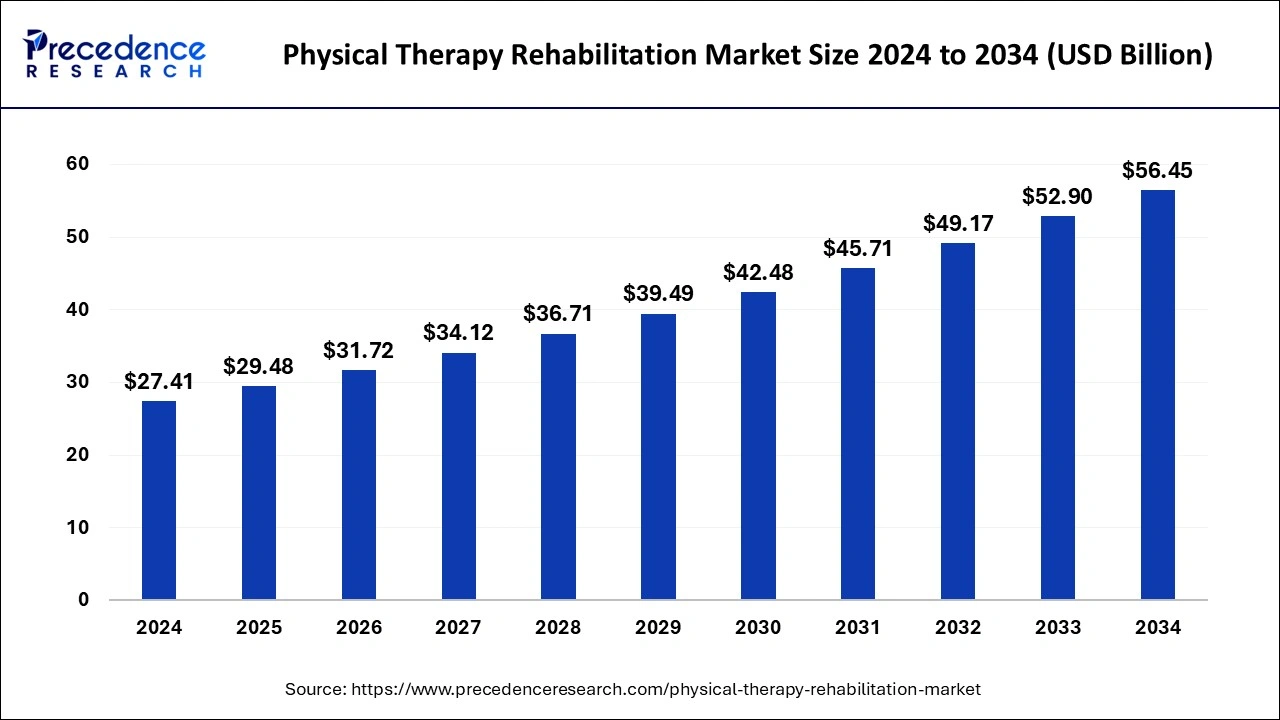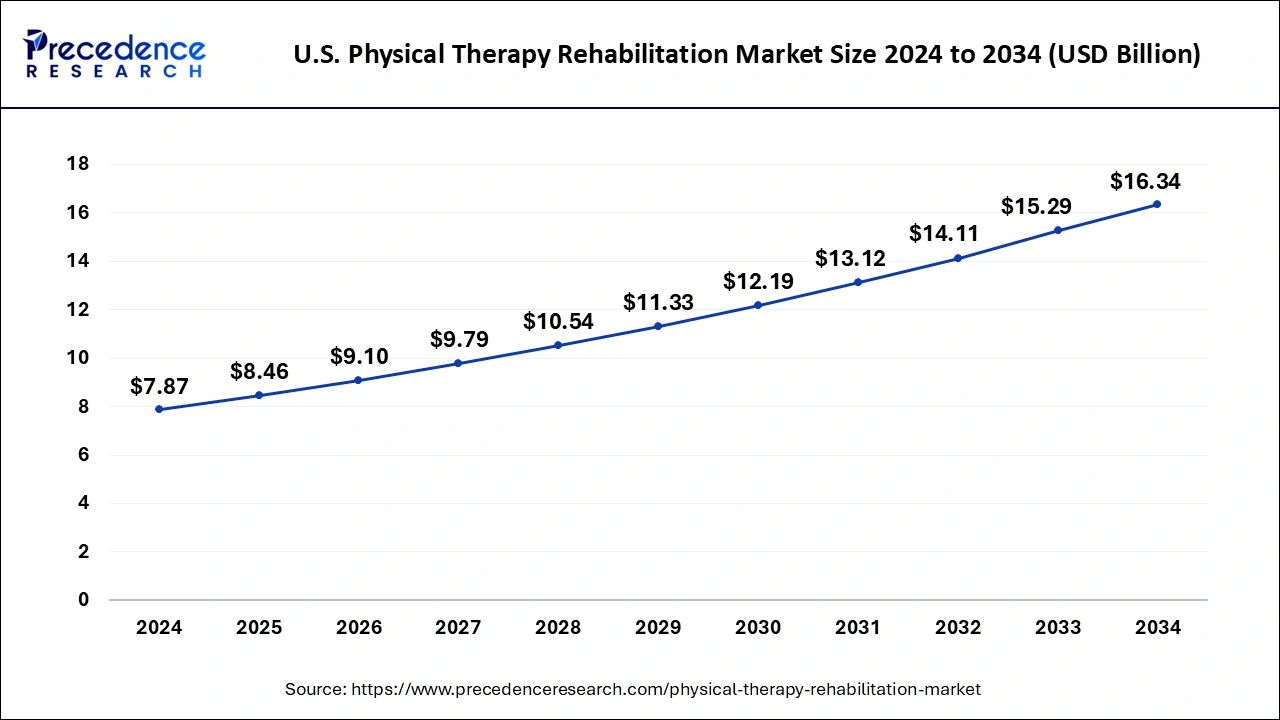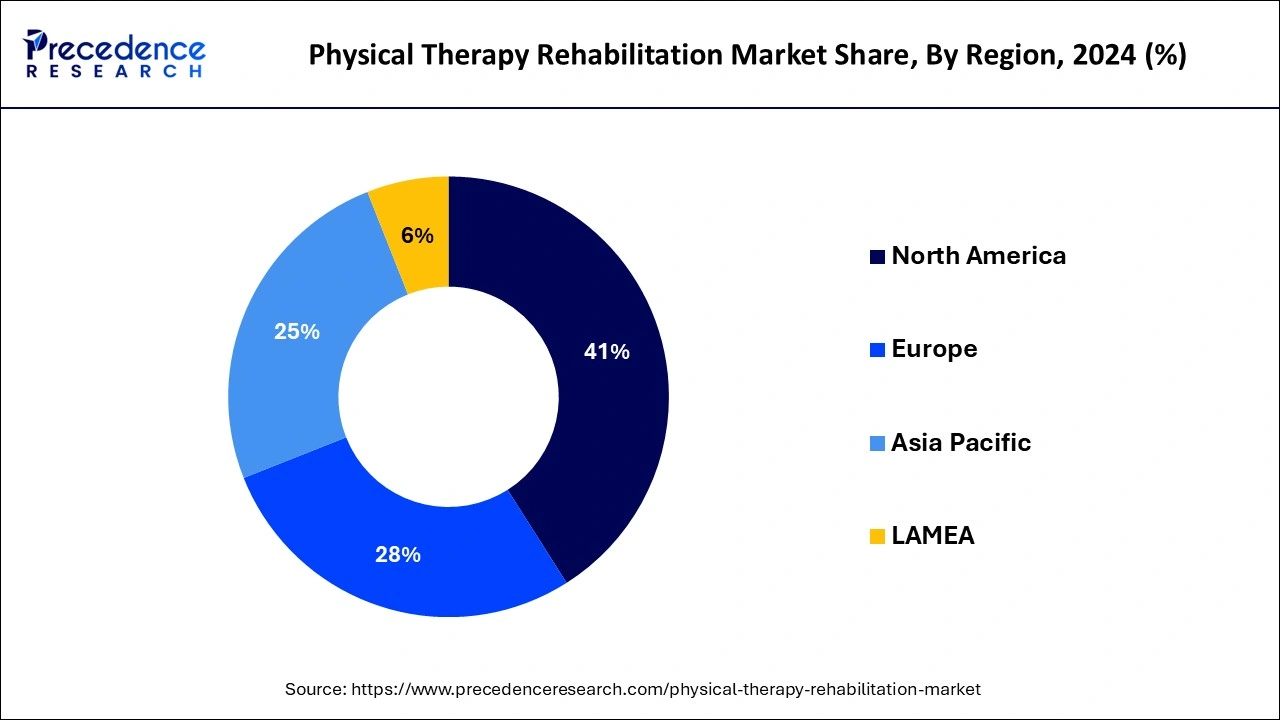List of Contents
- Last Updated : 02 Jul 2025
- Report Code : 4240
- Category : Healthcare
Physical Therapy Rehabilitation Market Size and Growth 2025 to 2034
The global physical therapy rehabilitation market size was estimated at USD 27.41 billion in 2024 and is predicted to increase from USD 29.48 billion in 2025 to approximately USD 56.45 billion by 2034, expanding at a CAGR of 7.49% from 2025 to 2034. The physical therapy rehabilitation market is driven by growing number of elderly people.

Physical Therapy Rehabilitation Market Key Takeaways
- The global physical therapy rehabilitation market was valued at USD 27.41 billion in 2024.
- It is projected to reach USD 56.45 billion by 2034.
- The market is expected to grow at a CAGR of 7.49% from 2025 to 2034.
- North America dominated the market with the largest market share of 41% in 2024.
- By solution, the hardware segment dominated the market in 2024.
- By application, the knee joint segment has held the major market share of 36% in 2024.
- By end-user, the physiotherapy clinics segment has accounted more than 31% of market share in 2024.
U.S. Physical Therapy Rehabilitation Market Size and Growth 2025 to 2034
The U.S. physical therapy rehabilitation market size was estimated at USD 7.87 billion in 2024 and is predicted to be worth around USD 16.34 billion by 2034, at a CAGR of 7.58% from 2025 to 2034.

North America has its largest market share in 2024 in the physical therapy rehabilitation market and observed to sustain the position throughout the predicted timeframe. Well-established health insurance programs cover most North American nations' physical therapy and rehabilitation treatments. Favorable reimbursement guidelines also encourage healthcare providers to supply these services, guaranteeing the market's longevity and financial stability. Customers in North America are becoming more conscious of the value of rehabilitation and preventative healthcare. Enhanced health literacy, along with educational initiatives and outreach campaigns, motivates people to choose physical therapy and rehabilitation treatments, fostering market expansion.

Asia-Pacific is the fastest growing physical therapy rehabilitation market during the forecast period. The Asia-Pacific market has grown tremendously due to physical therapy and rehabilitation techniques implementing cutting-edge technologies. Treatment results and patient experience have improved because of innovations, including virtual reality-based rehabilitation, robotic-assisted therapy, and wearable gadgets for progress monitoring. These developments in technology draw people looking for cutting-edge, efficient rehabilitation treatments. New clinics, hospitals, and rehabilitation facilities have opened in the region's growing economies due to rapid urbanization and infrastructure development. Physical therapy treatments are now more widely accessible thanks to the development of the healthcare infrastructure, especially in isolated and underprivileged areas.
Europe is observed to grow at a notable rate during the forecast period. Europe has a significant aging population, with a growing number of elderly individuals experiencing age-related musculoskeletal conditions, chronic diseases, and disabilities. As a result, there is increasing demand for physical therapy rehabilitation services to address mobility issues, pain management, functional limitations, and overall quality of life in older adults. European healthcare systems increasingly emphasize preventive healthcare and early intervention strategies to promote population health, prevent chronic diseases, and reduce healthcare expenditures. Physical therapy rehabilitation is recognized as a key component of preventive healthcare, offering services such as injury prevention programs, ergonomic assessments, workplace interventions, and lifestyle modification advice to minimize musculoskeletal risks and improve overall well-being.
Market Overview
The physical therapy rehabilitation market pertains to the segment of the healthcare industry concentrated on offering rehabilitative services to people recuperating from ailments, surgeries, injuries, or disabilities. This market includes various services that use different therapy methods, exercises, and modalities to help patients regain mobility, functionality, and quality of life. It prioritizes individualized requirements, objectives, and preferences while emphasizing patient-centered care. Physical therapists encourage patient participation and treatment adherence, which improves patient outcomes by involving the patient in the design of the course of therapy and establishing a collaborative therapeutic relationship. By providing non-invasive pain management techniques, physical therapy helps patients lessen their need for drugs and intrusive treatments.
Physical Therapy Rehabilitation Market Growth Factors
- Physical therapy is becoming more and more necessary for older people with age-related illnesses, including osteoporosis and arthritis.
- An increase in long-term illnesses that need physical therapy for treatment, such as diabetes, heart disease, and neurological problems.
- Accessibility is improved when physical therapy services are covered by insurance.
- Chronic disease patients who live longer need continual rehabilitation.
- Expanding knowledge of the benefits of physical therapy for reducing injury risk and enhancing general health.
Market Scope
| Report Coverage | Details |
| Growth Rate from 2025 to 2034 | CAGR of 7.49% |
| Market Size in 2025 | USD 29.48 Billion |
| Market Size by 2034 | USD 56.45 Billion |
| Largest Market | North America |
| Base Year | 2024 |
| Forecast Period | 2025 to 2034 |
| Segments Covered | By Solution, By Application, and By End-user |
| Regions Covered | North America, Europe, Asia-Pacific, Latin America, and Middle East & Africa |
Market Dynamics
Drivers
Prevalence of chronic conditions
Physical therapy is constantly changing with technological improvements, treatments, and rehabilitation procedures. With a focus on those with chronic diseases, these technologies seek to improve patient outcomes, expedite recovery, and increase rehabilitation programs' effectiveness. Some examples are virtual reality rehabilitation, robotic-assisted therapy, and fitness regimens customized for certain chronic conditions. Changes also influence the demand for physical therapy rehabilitation services in reimbursement patterns and healthcare policy initiatives. To enhance population health outcomes and control healthcare costs, governments, and insurers may give financing priority to programs that manage chronic diseases, provide rehabilitation services, and promote preventive treatment.
Growing awareness of preventive healthcare
Many firms understand the benefits of funding preventative healthcare initiatives to raise worker productivity and well-being while lowering medical expenses. As a result, there has been a discernible increase in workplace wellness initiatives that include physical therapy rehabilitation treatments as a component of overall health programs. These initiatives encourage staff members to put their musculoskeletal health first and avoid injuries. These initiatives include ergonomic examinations, injury prevention training, and subsidized access to physical therapy services.
Restraint
Limited access to specialized equipment or facilities
Access to specialist equipment or facilities may be restricted or nonexistent in rural or underserved areas. Patients in these areas frequently encounter difficulties accessing healthcare services, including physical therapy, because of a lack of resources and infrastructure. For many patients, accessing specialized facilities might be prohibitively expensive, even in urban regions where they are present. Insurance coverage might not cover all the costs of using specialist facilities or equipment, which could result in unequal access depending on socioeconomic level.
Opportunity
Increasing participation in sports and fitness activities
Sports and fitness-related activities can result in injuries that range in severity from mild strains to more severe ailments like fractures or tears in the ligaments. Physical therapy is invaluable when it comes to preventing injuries and expediting the healing process. The need for physical therapy services to avoid injuries through education, appropriate training methods, and rehabilitation programs grows as more individuals participate in physical activities. Numerous towns and companies fund wellness programs to encourage staff members' well-being and output.
Sports and fitness possibilities abound in these programs, including corporate-sponsored fitness challenges, intramural sports leagues, and group exercise courses. Physical therapists can collaborate with local businesses, gyms, and community organizations to increase access to on-site rehabilitation services, ergonomic assessments, and educational programs on injury prevention and management.
Solution Insights
The hardware segment dominated the physical therapy rehabilitation market in 2024. To improve patient outcomes, hardware-based rehabilitation devices and equipment support functional training, movement aids, and focused exercises. By providing individualized and adaptable treatment plans, these tools enable patients and therapists to target rehabilitation needs, hasten recovery, and maximize rehabilitation outcomes. The world's population is aging quickly; thus, tackling age-related health issues and raising older individuals' quality of life is paramount. Fall prevention systems, mobility aids, assistive technologies, and other devices that support active aging and independence are all provided by hardware-based rehabilitation equipment specifically designed to meet the demands of the aging population.
The software segment is expected to grow at a significant rate during the forecast period. Software solutions equipped with outcome measurement and data analytics capabilities enable physical therapists to track patient progress, monitor treatment adherence, and analyze rehabilitation outcomes more effectively. By capturing objective data on functional performance, range of motion, strength, pain levels, and patient-reported outcomes, software platforms facilitate evidence-based decision-making, treatment planning, and optimization of rehabilitation protocols.
The development of advanced software solutions tailored to the needs of physical therapy rehabilitation has significantly enhanced the efficiency, accuracy, and effectiveness of rehabilitation interventions. Innovative software platforms incorporate features such as electronic health records (EHR), practice management, telehealth capabilities, outcome tracking, exercise prescription, and patient engagement tools, enabling physical therapists to deliver personalized and evidence-based care.
Application Insights
The knee joint segment dominated the physical therapy rehabilitation market in 2024. Programs for physical therapy that concentrate on knee rehabilitation have evolved to become more focused and specialized. These programs include a range of knee ailments, such as post-surgical rehabilitation following surgeries like knee arthroscopy or total knee replacement, osteoarthritis, ligament injuries, and patellofemoral pain syndrome. These programs' specificity helps improve results and increase patient satisfaction.
The hip joint segment is observed to witness the fastest rate of growth during the forecast period in the physical therapy rehabilitation market. Hip-related conditions such as osteoarthritis, hip fractures, hip dysplasia, and sports injuries are increasingly common, particularly among aging populations and individuals engaged in physically demanding activities. These conditions often require rehabilitation to improve mobility, reduce pain, and restore function, driving demand for physical therapy services targeting the hip joint. The aging population worldwide is susceptible to age-related degenerative changes in the hip joint, leading to conditions such as osteoarthritis and decreased mobility. As the elderly population grows, there is an increasing need for physical therapy interventions to manage hip joint problems, improve functional independence, and enhance quality of life.
End-user Insights
The physiotherapy clinics segment dominated the physical therapy rehabilitation market in 2024. Highly skilled and specialized physiotherapists are frequently housed in physiotherapy clinics. These specialists receive in-depth instruction in anatomy, physiology, and therapeutic modalities. Because of their experience, they can offer specialized rehabilitation programs to patients with various demands, including neurological problems and sports injuries. Occupational therapists, doctors, surgeons, chiropractors, and other healthcare professionals frequently collaborate with physiotherapy clinics. This integrated network makes multidisciplinary approaches to rehabilitation, rapid referrals, and seamless care coordination possible. Physiotherapy clinics may handle complex situations fully and guarantee continuity of care throughout the patient's recovery process by collaborating with other medical providers.
Physical Therapy Rehabilitation Market Companies
- Reflexion Health
- AC INTERNATIONAL EAST
- Cerner Corporation
- Kareo, Inc.
- Therapy Sync
- eviCore Healthcare
- Meditab
- Isalus
- Smith+Nephew
- CoRehab SRL
- Hinge Health, Inc.
- SWORD Health, Inc.
- MIRA Rehab Limited
- Motekforce Link
- Gesture Tek Health
Recent Developments
- In March 2024, Together, the European Union (EU) and the United Nations Development Programme (UNDP) created the "School of the Physical Therapist of the Future" program to meet the growing need for rehabilitation services in war-torn regions of Ukraine.
Segments Covered in the Report
By Solution
- Software
- Hardware
By Application
- Hip Joint
- Spinal Cord Injuries
- Forearms and Wrist Joints
- Shoulder and Elbow Joint
- Knee Joint
- Others
By End-user
- Ambulatory Surgical Centre
- Self-insured Employer
- Healthcare IDN (Integrated Delivery Network)
- Commercial payer
- Physiotherapy Clinics
- Government Organization
- Hospitals
- Homecare & Rehabilitation Centers
By Geography
- North America
- Asia Pacific
- Europe
- Latin America
For inquiries regarding discounts, bulk purchases, or customization requests, please contact us at sales@precedenceresearch.com
Frequently Asked Questions
Ask For Sample
No cookie-cutter, only authentic analysis – take the 1st step to become a Precedence Research client
Meet the Team
Related Reports
January 2025
June 2025
July 2025
February 2025
